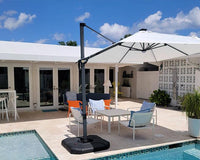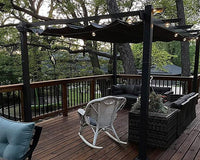There's something magical about eating outdoors, isn't there? Whether it's a weekend morning breakfast or a night out with friends, an outdoor dining space can really make your home life special. But attempting to figure out the best way to plan it can be daunting. This article is all about practical tips to assist you in creating an outdoor dining space that isn't just gorgeous but also makes the most of your space and keeps things running smoothly.
1. Know Your Canvas
Before you even think of furniture, give it a good hard glance. Grab a tape measure and get its dimensions. Is it long and thin, a neat square, or more of an irregular shape? Look at where the sun hits at different times of day and which way the wind seems to blow.
Also mark any fixed features like big trees, slopes, in-built planters already installed, or parts of your house that stick out. They will all come into play with your design. And be practical about what you want to use the space for – quick family meals, big BBQs, or romantic dinners for two?
2. Choose Tables & Seating
Your table and chairs are the stars of the show. When picking them out, think about how much space you have, how many people you usually entertain, and your personal style. Round or oval tables are generally better for conversation and make it easier to walk around in smaller spaces. Square or rectangular tables can seat more folks and often tuck nicely against a wall or into a corner.
For seating, you've got options. Chairs with arms offer more comfort, while benches can squeeze in more people and slide under the table when not in use. If space is really tight, look for chairs that can stack or fold away easily.Making the right choice involves several key considerations to ensure your dining set perfectly fits your needs and space.

3. Make the Most of What You've Got
Even if your outdoor area is on the smaller side, you can still create an awesome dining spot. The key is to pick furniture that’s the right scale for the space – big, bulky pieces will just make it feel cramped. Think about using vertical space too, like wall-mounted shelves for dishes or hanging planters for a touch of green without taking up floor space.
Multi-functional furniture is a good choice for a small space. Consider a bench with built-in storage underneath, or stools that can double as side tables. For super tiny areas, a fold-down table that attaches to a wall or railing can be a game-changer, freeing up tons of room when it's not mealtime.If you're looking for even more ingenious ways to optimize compact areas, there are plenty of creative strategies to explore.
4. Ensure Easy Movement
Nobody likes bumping into things or feeling squeezed. Good flow is crucial for a comfortable outdoor dining experience. Make sure there's a clear path from your house to the dining area, and from the dining area to other parts of your yard, like the grill or a lounge spot. Aim for at least 36 inches of width for main walkways so two people can pass or someone can carry a tray easily.
You'll also want enough room around the chairs for people to sit down and get up comfortably – generally, about 24 to 30 inches between the back of a pulled-out chair and any wall or obstacle. Avoid packing furniture in too tightly; it's better to have a little extra elbow room.
5. Amp Up the Comfort & Vibe
A great outdoor dining area isn't just functional, it's also inviting. Shade is a must-have, whether it’s a large umbrella, a retractable awning, a permanent pergola, or even just the natural canopy of a mature tree. This will let you enjoy your meals even when the sun is blazing or there's a light drizzle.
Lighting is very important for evening events. Both ambient light (e.g., string lights or wall sconces) and task lighting (e.g., a pendant over the table or lanterns) are ideal. Don't forget the floor too – make it level, slip-resistant, and cleanable. Wood decking, stone pavers, or outdoor tiles are good choices.

6. Layout Ideas for Different Spots
If you have a long, narrow balcony, consider a long, narrow rectangular table with benches, or a bar-height table and stools facing the view. If you have a square patio, you have more flexibility – you can put the table in the middle or move it off to one side in order to leave more room for socializing or kids to play.
Got a big yard? Divide it into multiple "zones." You may have your main dining area, followed by a separate area for barbecue, a mini outdoor bar, or a cozy sofa area for after-dinner lounging. Connect these zones with clear pathways or use plants to provide soft divisions.

7. Durability & Upkeep
Outdoor furniture must be able to withstand sun, rain, and whatever Mother Nature throws its way. Material, then, is an important consideration. Hardwoods like teak and eucalyptus are extremely durable against wear, metals like aluminum and stainless steel are lightweight and won't rust, and synthetic wicker gives the traditional look with sufficient weather resistance. Select easy-to-clean-and-maintain materials.
For cushions and pillows, use water-resistant and UV-protected outdoor-grade fabrics. Store fabrics away or cover furniture when not in use so that they can last longer. A bit of maintenance of your furniture and a quick sweep of the area will keep your outdoor dining space in great shape.
Wrap It Up
Designing an amazing outdoor dining layout is all about clever planning and paying attention to the details. By thinking it through, selecting the proper furniture, ensuring everything ties in together beautifully, and incorporating those cozy touches, anyone can create an outdoor dining oasis. Perhaps these tips have ignited some creativity for your own ideal al fresco setup!




